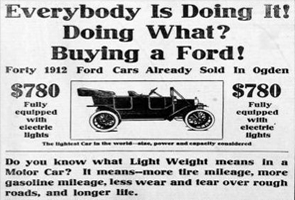With the constant development of new technologies and constantly shifting business paradigms, it’s easy to look at print advertising and think that it’s an obsolete medium, and yet the print industry thrives, even in 2015. What’s the secret?
Simply put, print has done an incredible job of evolving in tandem with other technologies. For example, direct mail still manages to maintain a large share – nearly half – of total advertising revenues for local businesses. A Pitney Bowes survey last year also showed that more than three-quarters of small businesses regard print as an important part of their marketing strategies.
Simply put, print definitely is an effective advertising tool and will be so for the foreseeable future. Here’s a few examples of how print has managed to integrate itself into new technologies.
Variable Printing
Variable printing is a process that allows customization for each piece of media through changes to certain elements. This allows for a high degree of personalization to the content.
Advancements in technology have actually made this process a good bit easier and faster over time, and the applications for it are virtually endless. For example, you could set up a direct mail campaign and create coupons that have unique codes. This allows you to track who is using your coupons, where they live, etc. You can also vary images to reach different demographics with the same message.
While not as instantaneous, personalized print media is much more effective than a personalized email, because the audience recognizes the effort it takes to customize something tangible. When a person receives a personalized direct mailing, it helps build a relationship between that person and your brand.
QR Codes and NFC Technology
The advent of QR codes and near field communication (NFC) technology has opened up yet another new avenue for print marketing.
You can customize QR codes with patterns and colors to better integrate them into your print marketing designs. They also provide you the opportunity to include branded elements in your design.
NFC technology has made it possible for print media to connect customers directly to your website by integrating digital communication with noticeable print advertising. While not available in every mobile device (yet), NFC uses tiny microchips to send signals to mobile devices. It has a decided advantage over QR codes in that there is no need to scan anything. Usually just a tap of the device to a piece of print media is all it takes to connect to a website.
Print Ads and Social Media
Social networking has become a vital avenue for marketers and entrepreneurs to engage new and existing customers, but the concept of networking is much older than social media (and the Internet for that matter). Think about it: What is a business card? It’s a social networking device: You are making a social connection with the person when you give him or her your card. Too often, we neglect to realize that the concept for online social media had to come from somewhere, and that somewhere has quite a bit to do with print.
Print marketing also meshes well with social media. These days, it is virtually unheard of to receive a business card from any serious businessperson or entrepreneur that doesn’t have the URL to at least one social media account on it, perhaps more. The reason for this is simple: People respond to them. A recent Nielsen survey of small business entrepreneurs found that more than half of the respondents had successfully used social media advertising in print ads. The right visuals and a strong message in print can go a long way toward drawing attention to your social media profiles, which can only serve to reinforce your print campaign.
TIP: Add customer comments from your social media profiles to your printed marketing materials. This will increase the effectiveness of your marketing efforts.
The Old ‘Less is More’ Argument
It’s true: Many companies are beginning to funnel advertising dollars that used to be spent on print ads into online endeavors. What that means for you is that with fewer print ads out there, yours will stand out more these days than they would have even five years ago. You have a great opportunity to fill a void in the marketing arena and capture the attention of a larger number of prospects as well as build brand recognition more easily and effectively.
It’s Not Just Paper
Don’t buy into what the naysayers want to tell you about print marketing. The reach of print ads goes way beyond just brochures and business cards. Just look at all the places online that offer printing services, like CafePress and 4Imprint. What do these sites do? Their entire business is print advertising. Just because it’s on a coffee mug and not a business card doesn’t negate its effectiveness. If anything, it expands your reach and fuels brand recognition.
Print ads extend to magnets, buttons, stickers, pens, coasters, keychains, and T-shirts, too, and they can be some of the most powerful collateral in your marketing strategy. A recent study by the Advertising Specialty Institute showed that 84 percent of Americans retain information about a company better when presented with branded promotional gifts that include a corporate logo. You can supercharge the effectiveness with a catchy tagline or similar branded message.
By the way, if you need help with that branded message, any good copywriting company deals with both online and printed content, and a strong piece of custom writing that is tailored to your overall branding strategy can expand your reach even further.
